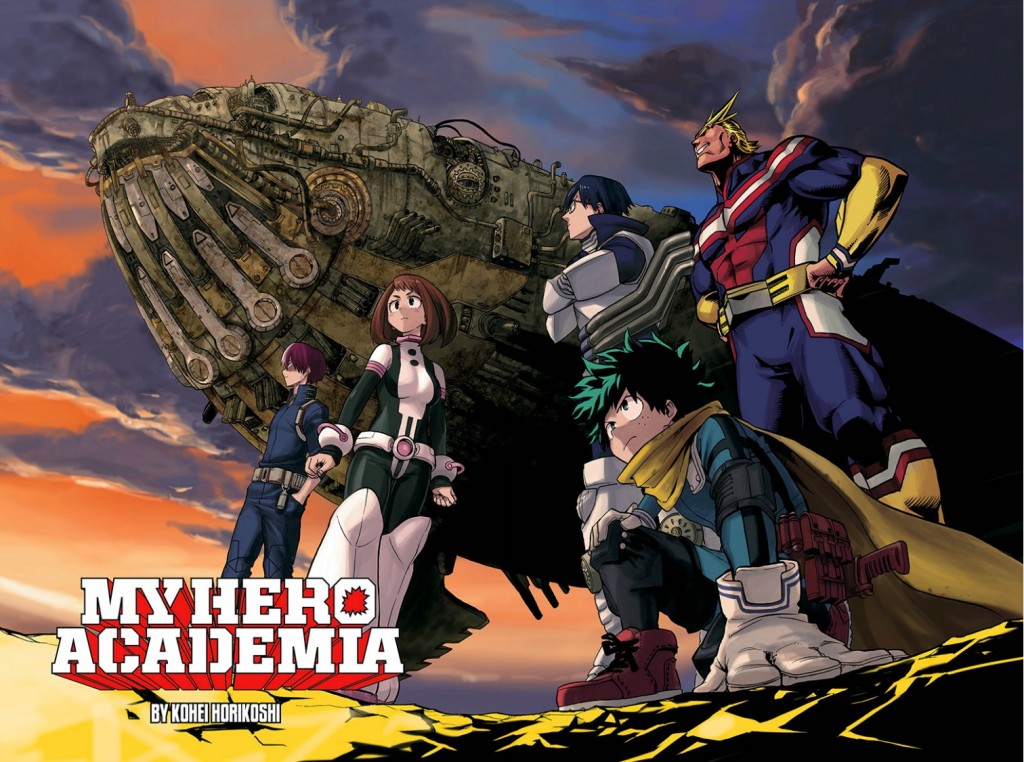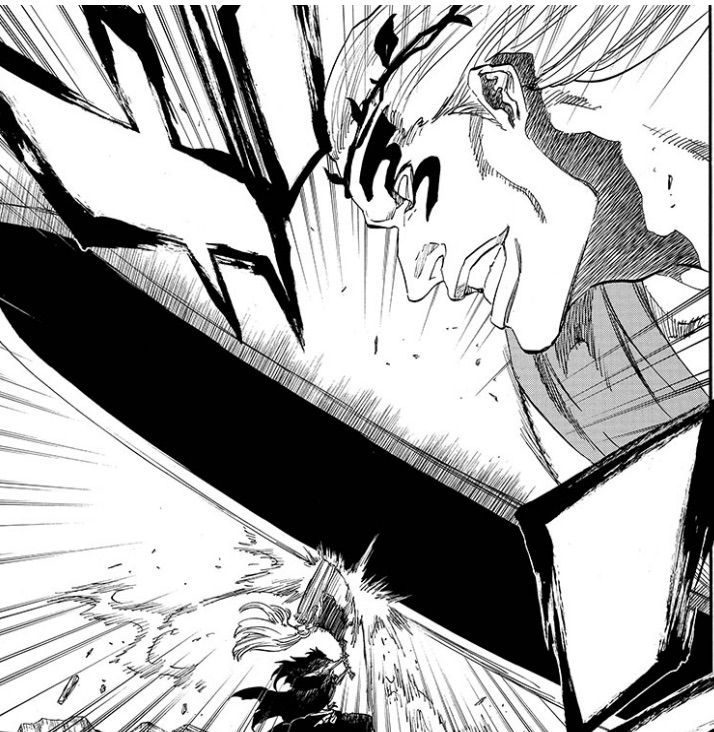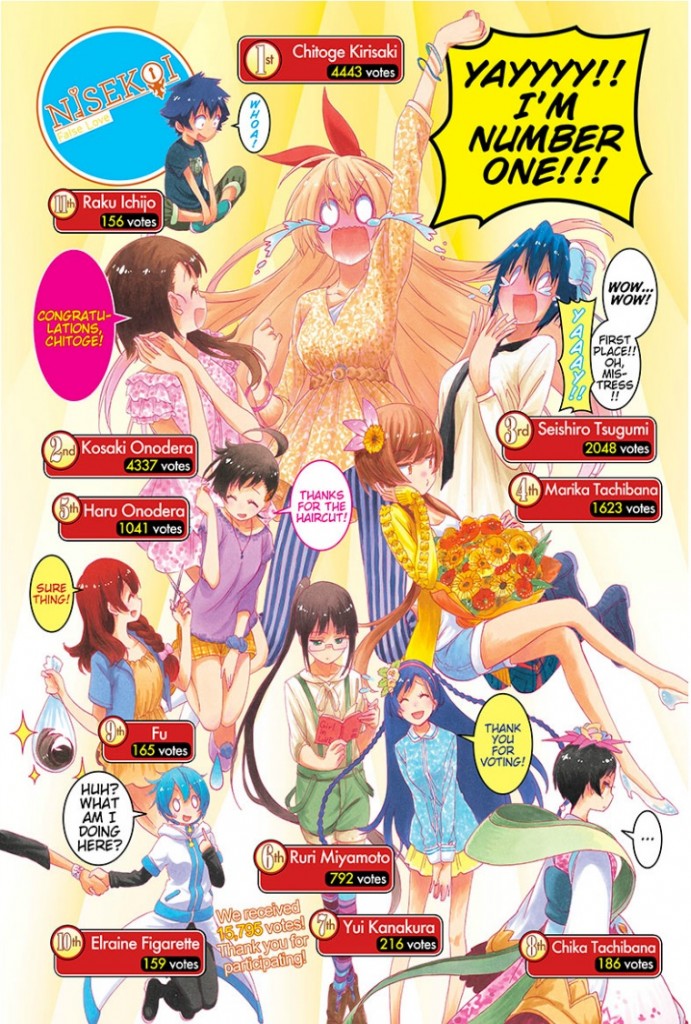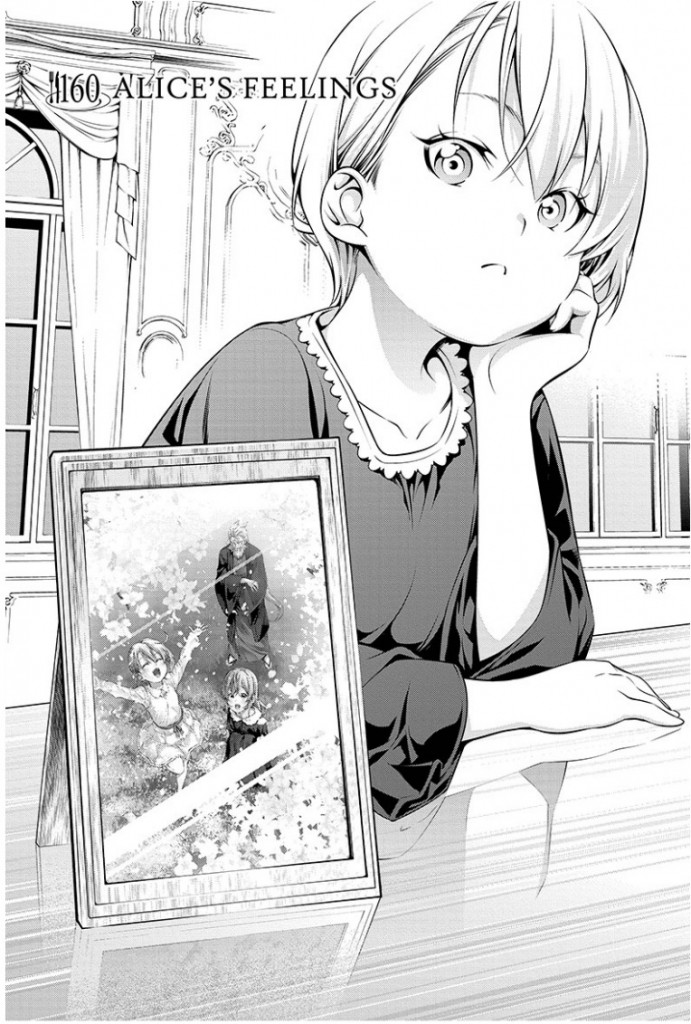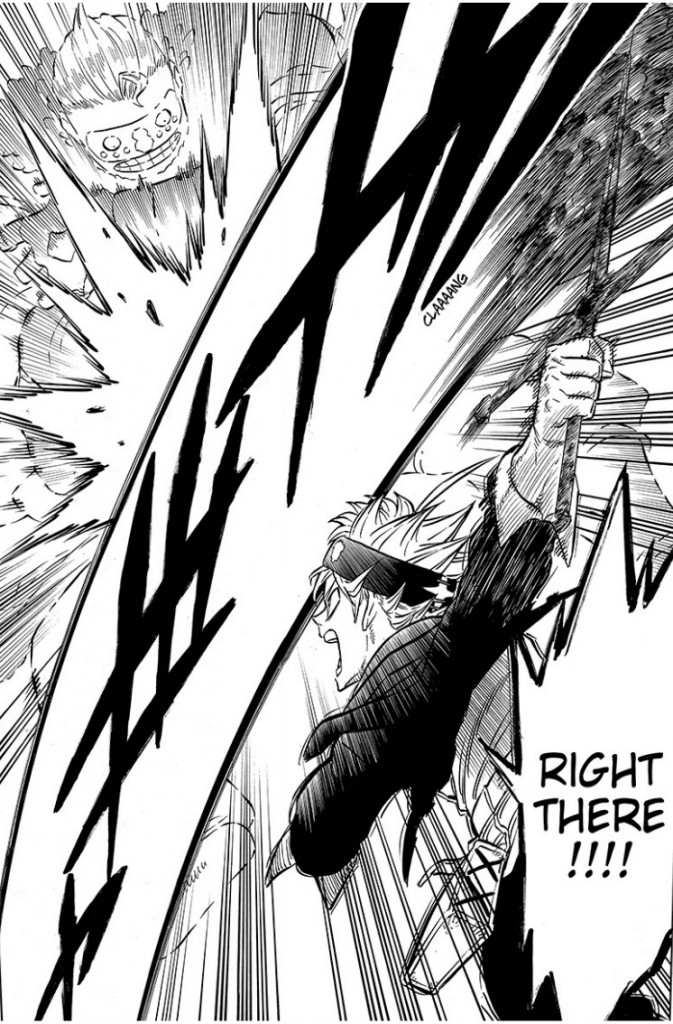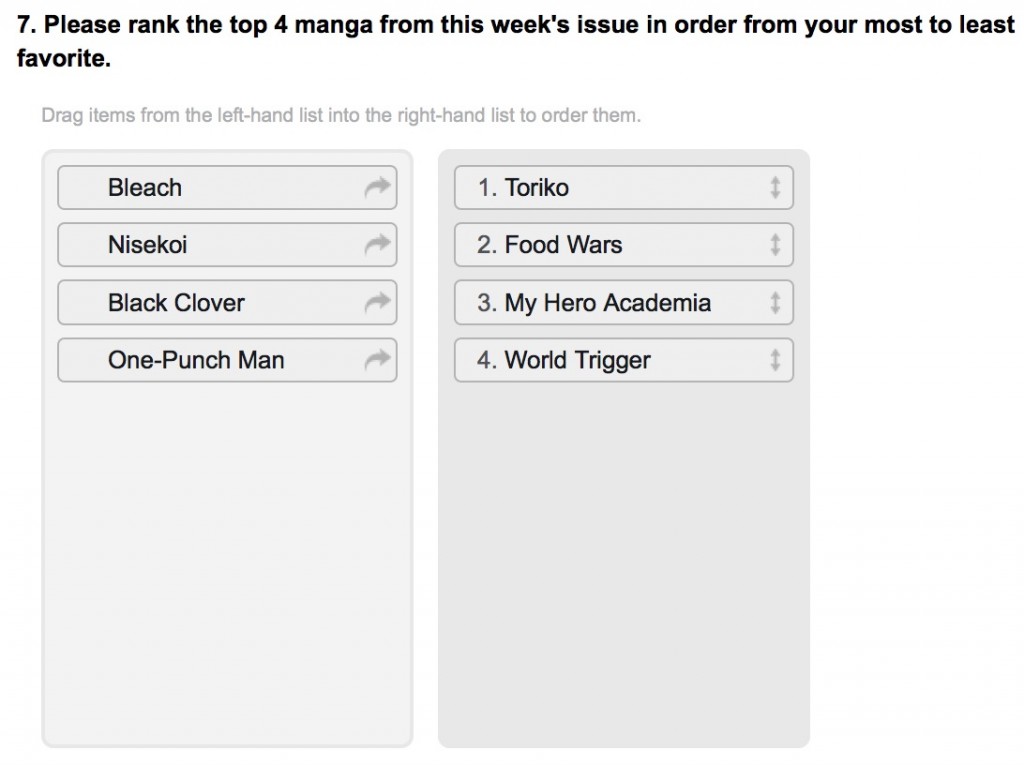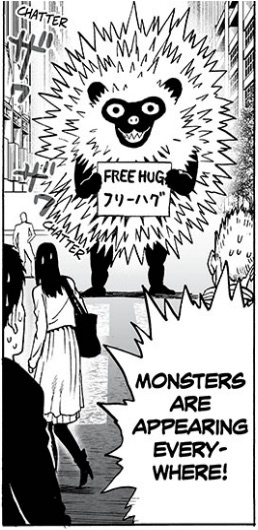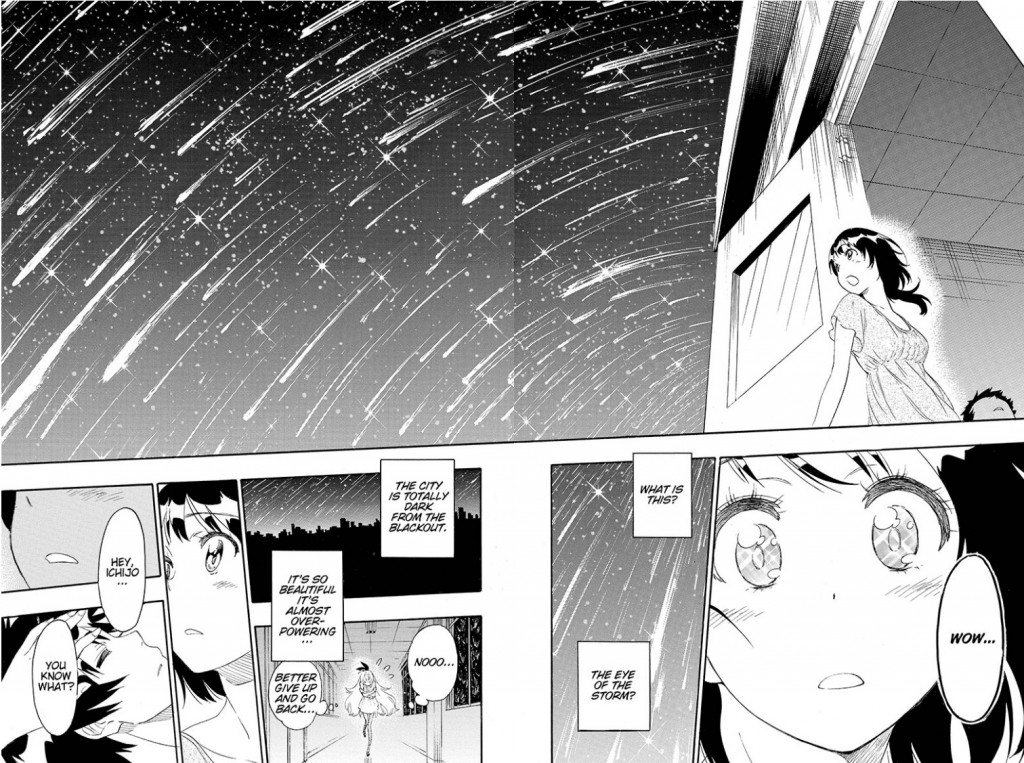04.01
It’s been a while, huh? No, this is no April Fools. The artist formerly known as Cartoon X is back and raring to review manga on here again. I never intended to take such a long hiatus from After the Jump, much less AR, but school and life kept me busy so hey, what could I do? There’s been several times I’ve hoped to jump back in, but I’ve just never found the time necessary to until now. Still, it’s a timely return. Not only does April see the premieres of several highly anticipated Shonen Jump anime adaptions, including My Hero Academia, as featured on this week’s cover, but there’s also a whole bunch of stuff coming to the magazine throughout April. The four-part Assassination Classroom side-story chapters, a new Naruto one-shot and the debut of the Boruto manga, not to mention the long-awaited return of Hunter X Hunter: April is packed with exciting new things debuting issue after issue. Add on top of that how strong a lot of series have been going lately, and now seems like as good a time as ever to jump back in and continue with these issue reviews.
While I haven’t written about Jump in a while, I’ve still been writing about manga elsewhere. I currently write weekly simulpub chapter reviews for new chapters of Fairy Tail, The Seven Deadly Sins, and Yamada-kun and the Seven Witches over at All-Comic.com, so if you prefer Weekly Shonen Magazine’s stuff to Jump’s head on over there and check those out. Also worth nothing is that I’ve also started a manga podcast on All-Comic called Manga Mavericks, in which me and my co-host Colton Solem from Life Lessons: The Gintama Mangacast run down the latest in manga industry news, and comment on topics pertinent to the western manga fandom. We’ve done about five episodes now, and I feel we’re starting to hit our stride, so if you like listening to manga podcasts feel free to check those out sometime as well.
But enough shilling, let’s start reviewing! While this week’s short issue length allowed me to cover these series to my usual level of depth, I’ll probably have to keep them briefer for at least the next few weeks simply out of time constraints. That said, every chapter this issue had a facet worth talking and thinking about, and it was satisfying just to write about these series again after such a long time. So without further ado, let’s get to it. In this week of Jump, a porcupine wants a hug, the Don doggone dies, and Raku loses in a character popularity poll to someone who isn’t even from his series. Who says Nisekoi isn’t hilarious? All this and more, After the Jump!
Weekly Shonen Jump: 2016, Issue No. 17
My Hero Academia chapter # 84 – “From Ida to Midoriya”
The title of this chapter directly calls back to chapter #53 – “From Todoroki to Ida,” when Todoroki came to Ida’s aid and made him realize just how foolhardy his revenge was and that he lost sight to what makes a real hero. Todoroki took that lesson to heart, and he now takes it upon himself to stop his friends from making the same mistakes he did. Midoriya and co.’s attempts to rescue Bakugo on their own is a dangerous act of vigilantism no better than what Ida once did. Their actions will have ramifications of U.A. whether they mean them to or not, and if they get hurt, especially if Midoriya gets hurt, that might be the end for them as a hero. Moreover, it’s simply selfish to put themselves at risk. Ida feels betrayed and frustrated that Midoriya is so adamant about rescuing Bakugo that he’s ignoring the effect his actions will have on the people closest to him.
It’s only natural he feels this way. He made the same mistakes once, and now the friends that helped him see the error of his ways are falling down the same path, and he feels powerless to stop them. Ida might be even more frustrated than Midoriya and Todoroki that Bakugo was kidnapped because he wasn’t there to help his friends when they needed him. But as pathetic as he’s feeling, he’s not letting his emotions persuade him into doing something reckless. He knows he needs to act as the voice of reason and stop his friends from their suicide mission. Which is why he’s surprised, and a little relieved, when he learns that their plans are covert. It’s still vigilantism, but at least they aren’t out for revenge, but to recover.
Even though Midoriya’s resolve to rescue Bakugo is based in emotion, it’s coming from a heroic propensity, not a personal grudge. These characters know better, and are not simply retreading the same mistakes Ida made in the Stain arc. They know their limitations, and responsibilities, and are doing their best under those constraints to help a friend in need. As heroes do. Of course, it’s still nice that Ida is tagging along to keep a watchful eye. Not only is he redeeming himself from his crusade against Stain, and his inability to help during the villain assault, but he is level-headed enough to help the team strategically and keep everyone else from making risky and reckless decisions in the emotional heat of things. It’s a good place to take his character, and as you might guess from how I’ve spent three paragraphs talking about it, Ida’s character development here is easily the strongest and most satisfying aspect of this chapter.
On the flipside, the most unsuccessful aspect about it is yet another reinforcement that Midoriya is supposedly going to cripple himself if he overexerts himself too much. How many times have people had this conversation with him? It seems like he has to get lectured like this after every arc, but there’s yet to be any consequences because the series keeps pushing back what his breaking point is. Only a short while ago, it was said that 100% of All Might’s power would destroy him. But not only did he surpass that limit in a flight-or-fight response while saving Kota, but in spite of his arms being beaten and battered, he was still able to move and influence the outcomes of many fights right afterwards. It’s one thing for a hero to push himself past his limits and pain to help others, that’s admirable, but it’s a whole other for the series to state there will be consequences for doing so and then simply ignoring and delaying them. So, it’s going to take three or four more times using his full power for his ligaments to break? Fine, fair enough. But we better start seeing Midoriya become impaired because he’s over exerting himself, because right now it feels like he can tear his body to a bloody pulp and still be raring to go.
While I do have misgivings about the lack of consequences for Midoriya, there’s still plenty else good about this chapter that counteracts it. For one thing, it’s great to see a underutilized character like Kirishima finally get some more characterization and be a central focal character in an arc. Even more satisfying is seeing Yaoyarozu get to join in, following up on the character development given to her during the final exams and her actions in the last arc. I know the characters plan to avoid fights, and it’d be interesting if they manage that, but in the event things fall apart and they do have to fight, hopefully they’ll get some ones to themselves. Bakugo gets a great moment here, telling Shigaraki to shove it and refusing his offer to join his team. It’s a relief to see that Bakugo is resolved to be a hero and isn’t being tempted to go rogue, especially since the premise of this arc is so similar to Naruto’s “Sasuke Retrieval” arc otherwise. Not that the arc’s foundation is necessarily weaker for being so similar to that, but it’s good to see a more variations on it all the same since comparison’s are nonetheless going to be made. With both Midoriya’s group and an elite lineup of heroes poised to infiltrate the villains’ headquarters, and promises of a “greater incident” to come, there’s a lot of promise and potential in the upcoming arc and with MHA’s hot-streak it should prove a unique experience to be sure.
Bleach chapter #667 – “Bigger, Louder, Stronger”
For someone considered one of the five variables that pose a threat to Ywach’s plans, Kenpachi has been less than impressive in this arc. Yeah, he finally unlocked his Shikai and whatever, but he’s also lost every fight he’s been in, with the sole exception of Gremmy, which was not only the worst fight in the arc so far, but maybe even Bleach as a whole, and that’s really saying something. While Kenpachi’s fans like his “kill first, ask questions later” attitude, that mentality has repeatedly screwed him over fight after fight this arc, here being no exception. What’s infuriating is not only doesn’t he learn from his mistakes, but he doesn’t consider the consequences of his actions, being so foolhardy to just keep cutting up Gerard when that only makes him stronger and threatens to crush Soul Society if he ever slips. Kubo keeps trying to make Kenpachi out as some kind of badass, but instead, he just makes him look like an idiot. For however strong the character supposedly is, it means nothing when we see him consistently lose because he makes bad decisions that he could’ve easily avoided.
With both Kenpachi and Byakuya facing off with a giant opponent, this fight feels like the Yammy fight that we never saw. Except Hitsugaya’s here, and Byakuya isn’t doing jack shit. But hey, if these characters pooled their strength and each contributed to the fight, that might be satisfying. But if Kenpachi just takes a fall here so that Hitsugaya and Byakuya look better in comparison when they take out Gerard, well, that’d be in line with how all the other fights with Ywach’s elite squad have gone at least. There really isn’t much else to say here. The fight itself is very non-descript, and very uninteresting visually in spite of all the slashing going on. One thing to note is that Gerard might have an “eye for an eye” thing going on, where whenever his opponent chips or damages his sword his opponent is hurt in turn. That definitely makes the challenge harder for the protagonists, so hopefully we won’t see them follow Kenpachi’s example and actually use their brains to beat Gerard instead of just hitting things good and seeing what happens.
Toriko chapter #364 – “A Thought!!”
Don Slime’s supernova explosion is given a lot of buildup, and rightfully so. It’s a kamikaze move, planning to take Neo out with him. This is supposed to be the Don’s shining moment, a bittersweet victory, but going out on his own terms and no regrets. The panel where the move flashes, and moves through the clouds, almost makes it feel like the Don is ascending to heaven, to reunite with Ichiryu once more in death. That image also characterizes how big and how powerful the move it is. The flash goes through the clouds and peeks out the top of the earth, expanding still, and perhaps would’ve grown even further until…it pops. It’s an anti-climax, but an effectively jarring one. Contrary to the build-up, things do not go as Don Slime planned nor as the reader might’ve predicted.
Neo didn’t simply block supernova or diffuse it with one of his own. He ate it.
This turn of events causes the Don to reflect on his reunion with Ichiryu in the Spirit World. Ichiryu’s attitude about his death and the impending crises is fascinating, to say the least. Ichiryu refuses to come back to life on the fundamental principle that the dead shouldn’t. Death is a part of a longer journey of the soul, where it’s reborn into new forms, creating stronger people over the course of millennia. Ichiryu’s life may have been brief when compared to the grand scheme of this cycle of evolution, but he believes that he died when he did for a reason, and for the benefit of the next generation. Ichiryu refuses the Don’s plea out of this existential philosophy, and it’s perfectly in line with not only his character, but the series’ themes of equating appetite with humans’ ambition to improve and better themselves in search of both hedonistic and spiritual fulfillment. Ichiryu sees Neo as a necessary development in this process of evolution. The fight between him and Toriko’s generation will be an experience that, while harrowing, will help humanity become stronger, perhaps taking to the stars to seek out other worlds like the ones Neo and the Nitro come from. Ichiryu is looking at this bigger picture, and as someone who’s already had his chance to affect the lives of others and is satisfied with his accomplishments, sees no need to intervene in the course of things further. At the same time, he exudes a sort of confidence that humanity will survive their encounter with Neo. He believes in Toriko’s generation, and that this encounter will answer questions long asked.
The philosophical conversation between Ichiryu and the Don is a brilliant way not only to give a sense of closure between the two characters for the reader, but to reestablish the series’ central theme and the real weight behind the battle with Neo. Not only does this reinforce that yeah, Neo’s fucking scary, but it also reinforces Ichiryu’s statement about Neo and its appetite being otherworldly. It’s not just because he’s an alien: even the Nitro say that he’s different from them. Rather, his appetite is so extreme, so bottomless, that he seems like almost a godlike or demonic creature, and given his appearance probably the latter. Considering Neo threatens to consume the entire universe, he’s certainly a harbinger of doom and a threat beyond the likes of any mortal man to extinguish. Neo was already a mysterious creature, but with the narrative giving him a thematic backing, he feels even more intriguing and dangerous than before. Even if you don’t find his design “scary,” I’d say the true horror is the potential ramifications Acacia’s cruel personality and Neo’s unquenchable appetite might have, and on that level Neo is one of the scariest antagonists I’ve seen in a shonen series in recent memory.
While those points alone make this an incredible chapter, perhaps the most affecting aspect about it is the Don’s reaction to Neo devouring the supernova, and his untimely demise. This is the first time we’ve seen the proud and mighty Don actually shake in fear. For a character like Don Slime to actually be afraid is a big deal: these circumstances are equivalent to Vegeta’s emotional breakdown after seeing how ineffectual his strongest attacks were against Freeza’s final form in Dragon Ball. It doesn’t just build up the villain, but it breaks down the hero. The placement of the flash-back couldn’t have been more appropriate. Not only does it get behind what this arc and Neo as a character is really about, but it makes the switch back to the Don being eaten alive by Neo all the more horrifying. It’s a powerful image, Neo stuffing his face full of the Don’s face while he’s clinging to him, helpless, trying desperately to figure out just what he is while Neo demands he “scream…scream” in his blood-splattered face. And as the Don slowly realizes with what Neo is, and becomes aware of his own impending death, his eyes grow wider and wider in fear, until finally, a Blue Nitro stabs him in the back, which finally causes him to scream in pain to Neo’s delight as he’s finally devoured whole.
Every time I’ve read this sequence, my mouth is agape in horror. It’s such a chilling death because of how it squashes on such a lovable and strong-willed character’s pride, forcing him to cry in pain, give into fear, just like his opponent wants. This is how you do a shocking death right. While unsatisfying and horrifying for someone who loves the character, it feels like an organic part of the story and is based on previously established characterization. Moreover, there’s a point to it. Not only does it make sense for the Don to lose here to give Toriko and his team a chance against the monster, but it’s the first really tangible expression of Neo’s power and capabilities. Yes, we know what he has and can done, but we’re detached from those incidents since they didn’t involve characters or concepts we cared about. Here, we’ve grown to know and care about the Don both because of his personality and his touching relationship with Ichiryu; he’s a character we want to see more of, and even if he lost here, still expected to. So this death, the first significant death of a protagonists in the series since Ichiryu’s, is incredibly effective in making us invested in seeing Neo’s demise. There needs to be vindication for Don Slime’s efforts, and it’s going to make his eventual beat down all the more satisfying because of them.
The shocks don’t stop with Slime, however. It looks like Neo’s going after Jiro next, and from the looks of him, Jiro’s become more of a monster than the Nitro themselves. As much as I’m afraid for Jiro’s life, I’m incredibly pumped to see that fight go down. The raw, primal energy of this chapter capture Toriko’s propensity for great, visceral action, while the philosophical and thematic purposes undermining it give a welcome depth to the bloody brawls. Pretty much everything involving Neo and Don Slime has done well to bring Toriko back to form these past few weeks, and here’s hoping the upcoming fight between Jiro and Neo will keep its momentum going.
Nisekoi chapter #211 – “Night of Falling Stars”
Let’s address the elephant in the room: not only did Raku not make the top 10 in the character poll, but he lost to Elraine, the female lead of the mangaka’s previous series Double Arts. That is incredibly amusing, and I’ve seen a lot of people who dislike Nisekoi but liked Double Arts feel vindicated by this. But people who read a harem series more often than not are reading it for the girls, not the guy, so despite Raku being the de faction main character him ranking lower than Elraine doesn’t say anything about one series being better or more popular than another (especially since Elraine has only 4% of the votes Chitoge has anyway).
That said, it does show how weak of a character Raku is. The least interesting character in a harem series always tends to be the male lead because he’s supposed to be a non-threatening blank slate that allows the male reader to invest in the fantasy of multiple girls having the hots for them. The problem with Raku is that he simply doesn’t have much of a personality. Sure, he’s nice, but that’s it. He’s not interesting enough to carry a chapter of the series without one of the girls co-staring, or at the very least Shu. More frustrating is that Raku generally doesn’t have any agency in the narrative. He spends most of the series’ runtime oblivious to the fact multiple girls are crushing on him, doesn’t confess his feelings to Onodera, and doesn’t realize he’s starting to like Chitoge. That changed last year thanks to the Yui Confession arc, after which Raku finally became an active character, taking responsibility by turning both Yui and Marika down, but rescuing the latter from her arranged marriage all the same. Finally, he also came to realize that he loved both Chitoge and Onodera, and became resolved to choose one before the end of the school year. These arcs, alongside the Chitoge moving arc from earlier in the year, are the few times Raku is given an actual character, much less feels like the main character of his series, and because of that the audience was actually able to be invested in his efforts.
Since then, however, Raku has once again slipped back into obliviousness. While both Tsugumi and Haru’s character arcs were resolved well, the fact that they came to terms with their feelings for him without him ever knowing they had any is frustrating and weakens the agency the character had built up throughout last year. Now, for a third time, a character has confessed to Raku without him knowing. If Onodera’s feelings for Raku are resolved the same way as Tsugumi and Haru’s, without him aware or involved in the decision, then it’ll really weaken Raku’s character arc and weaken the satisfaction of the final hookup.
That isn’t to say I didn’t like the chapter or confession scene. On the contrary, the chapter works because on the strength of Chitoge and Onodera’s character arcs, and how their relationship pays off in the final scene. The meteor shower that inspires Onodera’s confession is an awe-worthy, romantic moment, with the falling stars reflecting in Onodera’s shining eyes as she gazes at them awestruck and in wonder. It’s incredibly satisfying to see the shy, demure Onodoera then finally let her feelings out, even if Raku doesn’t hear them. What’s even more satisfying is that Chitoge finally learns that Onodera loves Raku. I said long ago that when Chitoge and Onodera realize that they both love Raku, that will test their friendship and force them to make a difficult decision. As the beginning of this chapter shows, Chitoge values Onodera as a friend as much as she does Raku, and the way she reacts, her eyes going white with shock and disbelief, shows just how taxed her mind is at this revelation. Forget Raku making his decision: the tested friendship between Chitoge and Onodera is going to be the real crux of this arc. While the end result probably won’t be heartbreak, it’s still going to be the most personal, and emotionally turbulent conflict between two characters in the series yet, and I’m very much looking forward to seeing where it leads in the chapters ahead.
World Trigger chapter #137 – “Katori Squad”
The Rank Wars resume as we see Tamakoma-2 prepare for their match against Kakizaki and Katori squads. It’s always interesting when World Trigger takes the time to develop Tamakoma’s opponents and show that they have as much at stake in these matches as our protagonists do. Of course, it’s very rarely feasible to give every member of an opposing team fully fleshed out characters (Nasu squad might be the only one of Tamakoma’s opponents where every member was explored in detail before the fight began), so the series generally chooses one or two characters to focus on and that’s true here. Only Kakizaki himself is given any notable personality or motivation among the members of his squad, frustrated that his team is as low as it is and desiring to win despite knowing what’s at stake for Tamakoma-2. A simple characterization, but enough to make us sympathetic for the character and give some purpose to the team’s involvement.
Whereas Kakizaki displays confidence and optimism despite his team’s standings, Katori is pessimistic and fatalistic. Not only can she not be bothered to participate in team strategy meetings, or care about who her opponents are, but she is completely unemotional and uninvested in the upcoming fight, instead playing around on her phone. But when her teammate Wakamura calls her out for her wishy-washy behavior and quitting streak, it strikes a nerve. We learn that despite being talented, Katori has lost heart in ever breaking down the barrier that separates her and the best, giving up because trying to push forward requires too much effort with no guarantee of success.
But as Wakamura points out, Katori isn’t weak because she isn’t capable, but because she doesn’t try. She and her team could reach A-Rank if she were to put in more effort, and give her all, but the problem is she’s doesn’t want to work hard. The reason she’s flip-flopped between so many positions is because she wants to be the best at something without having to work for it. She wants things to simply come easy and naturally to her: to rise in the ranks without having to strain herself too much. She’s invested enough to the point she’s frustrated that she’s lost, but at the same time, she’s runs away from something the moment it starts getting too difficult or she starts losing. It’s an interesting characterization, and while one might dislike Katori’s lazy attitude, they can also sympathize with the frustration she has not only because she keeps losing, but because she lets herself keep giving up, afraid to go the extra mile and truly get invested in something and risk the heartbreak of losing again and again.
Compared to Kakizaki, there are more multitudes to Katori’s personality and background explored here that make her a much more fully realized character in about the same amount of pages. Which might be why the chapter ends by jumping right into a confrontation with her and Yuma, trying to win the match single-handedly to get her teammates off her back. Despite only knowing this character for a couple of pages, I find her story interesting and compelling enough to want to see her do well in her fight with Yuma, even knowing that the story necessitates her losing here. One thing I like about the Rank Wars is that it’s introduced many new supporting characters in a compelling and natural way, building them up for long-term character arcs and future roles in the story going forward. The recent invasion arc payed off on characters established in the Rank Wars in satisfying ways, and hopefully the same will be true of Kakizaki, Katori, and their squads here. While I am getting a little impatient for the series for Tamakoma-2 to pass the Rank Wars, the series still finds ways to make these matches compelling and interesting enough that I’m still thoroughly invested in them, and I can’t wait to see how the fight between Katori and Yuma plays out in next week’s chapter.
Food Wars! chapter #160 – “Alice’s Feelings”
For the longest time, Erina’s discomfort hanging around the perpetually peppy Alice seemed like a part of her generally distant character. Now we learn that Erina’s awkwardness around her cousin isn’t because she can’t take a joke or deal with someone so hyperactive, but because she still can’t forgive herself for the pain she caused her due to not responding to her letter when they were children. Over the course of the series, Erina’s coldness towards people has been broken down and she’s become more comfortable expressing her feelings and socializing with others. As a consequence, it’s also made her regret things she’s done to people she cared about in the past. In the Stagiare arc, she realized that she had undervalued how much Arato’s friendship meant to her. And after Alice rescued her from Azami’s mansion, she started to feel a similar guilt for not trying to repair the bond between them, even though they were once so close.
Alice, however, never forgot what happened back then. But she also never blamed Erina in the first place. She knew that Azami was the reason that Erina never sent her any replies, and kept her walled away from her and the rest of the outside world, and she isn’t going to let it happen again. The relationship between Erina and Alice is incredibly moving. The small flashback we get of Alice writing letter after letter, checking her mailbox repeatedly for replies that never came, even in the rain, and the grainy panel depicting a young Azami seen from her perspective, tells us everything we need to know about how hurt Alice cared about Erina as a kid and how much she resents Azami for what he did. Even though her “I hate you” is rendered more comically than dramatically, the following declaration that she won’t let him have his way with her cousin and school anymore is still a powerful and resonant character moment, and one of the strongest acts of defiance against Azami yet.
It’s the effect her declaration has on Azami and Erina both that’s the most profound. Erina, of course, finally realizes that Alice has always been on her side and is truly there for her. Now that Erina is emotionally open and she knows that Alice holds nothing against her, these cousins can finally rekindle the strong friendship they once had. While that adds a lot of heart to the chapter, the meat is perhaps Azami’s reaction to all this. Never before have we seen him this frustrated and annoyed that one of his plans has gone awry. He took Eizan’s defeat in stride, and even when he found out that Soma’s father was his beloved senpai, he was more amused than anything else, musing about what Senzaemon’s scheme was. Here, though, he’s taken aback when Alice says she hates him, and is biting is thumb in frustration after withdrawing from the stadium. It’s clear that he sees Alice as more of a threat to his machinations than Soma, especially in the effect she might have undoing all the brainwashing and conditioning he’s imparted on her over the years. Considering his reaction, I think Senzaemon went to the wrong person for help. Soma is indifferent to helping Erina specifically, but Alice has been consistently proactive in helping her, and unlike Soma, Azami actually feels threatened by her endeavors.
This was such a strong character showing for Alice and powerful characterization of her and Erina’s relationship that I really hope it stays a focal point of the arc going forward. There’s much more compelling motivation and tension in Alice’s efforts to take Azami down then there is with Soma’s perpetual indifference, and it’d be nice if she or Erina could at least be the Law to his Luffy and become the secondary protagonist of the arc. As it stands, Alice has elicited more frustration in Azami than Soma’s escapades have, so here’s hoping her character arc develops further from here on out.
Black Clover chapter #55 – “The Captains and the Peasant Boy”
The Golden Dawn’s commander Vangeance seemed so obviously in league with the Midnight Sun that the series basically had to fake us out here or run the risk of being predictable. Unfortunately, this twist doesn’t have much bite considering that Poizot was only introduced in the previous chapter, and there hasn’t been enough time spent building him up as a shady or unpleasant character for us to really be surprised by it. In fact, all of Poizot’s characterization is dumped within a few brief exchanges this chapter, and his inner monologue reveals that while he is indeed corrupt and cowardly, his motivations do not correlate with clearly those of the Midnight Sun, and his denial of being involved with them and being set up is likely the truth. So, really, one can read between the lines and the detail that Vangeance doesn’t attack Poizot when all the other captains do, and being the one to suggest that he’s under mind control, to confirm that yes, William Vangeance in cahoots with the Golden Dawn and has set up Poizot to take a fall to keep his secret safe. That’s where this is going, and I’ll be surprised if I’m wrong about this.
I suppose that does raise questions as to how Vangeance was able to frame him considering the King’s assistant’s memory exchange magic is supposed to be absolute. Considering his line about mind control, he might be able to manipulate the thoughts of others subconsciously without them even realizing it, sort of like Tsukishima from Bleach. That might explain some things about why he can be so transparently shady but few question him; he’s gained their trust by imparting false memories about his efforts and accomplishments into their minds. This is all speculation of course, but considering that he’s so clearly trying to keep his abilities under wraps and takes no action whatsoever when Poizot’s supposed betrayal comes to light, it’s hard not to suspect he’s manipulating the entire scene. With how suspicious he is I wouldn’t be surprised if he just turns out to be Licht hiding his identity under a mask, but even that would be too obvious and contrived for Black Clover. Maybe.
While the series’ attempts to misdirect the reader’s attention away from Vangeance as the conspirator doesn’t work, I don’t think this is necessarily a bad chapter. It’s an enjoyable popcorn read thanks to it’s action beats, with the various Captains and Asta getting some neat shots in on Poizot as he attempts to flee. Admittedly, this all seems like an excuse to just show off what Rill can do, since we haven’t seen his abilities before, and make him and Asta friends. You know, for a supposed underdog who’s supposed to be looked down upon, Asta sure has a lot of friends in high places, huh? The series is undermining Asta’s underdog status faster than Naruto did for it’s title character. That would be find if Asta was still way below everyone’s level in strength, but the powerful shot he lands on Poizot, a captain, doesn’t really help his case. Sure, he’s in awe of the captain’s abilities and insane quirks, but that doesn’t really give us a good enough indication of the difference in power between him and them. We need Asta to lose against an opponent that a captain fights much more easily, which we almost got with Yami vs. Licht…only for Asta to land the finishing blow in the end. I’ve said it before, but Asta really needs to start losing against people who are supposed to be stronger than him, because right now he feels so overpowered that I wouldn’t be surprised if he gave One-Punch Man’s Saitama a run for his money.
Like I said, this chapter can be enjoyed because of how well-drawn the action is, but the more I start thinking about it critically, the more flaws I see in the execution of this twist, the characterization of Vangeance, and Asta’s capabilities. I’m curious as to where the plot with Poizot will lead, and where that will take the conflict with the Midnight Sun, but the way this chapter gets us there just doesn’t leave me as invested in the story as I’d ideally like to be.
One-Punch Man chapter #58, Part 2 – “Only You”
The fight between Metal Bat and Garo and Garo’s character development was so compelling that moving away from it makes this chapter feel underwhelming in comparison. Especially because this is really a set-up chapter, building up the crises at hand by showing the Monster Association’s operatives engage in fights with heroes in multiple cities. The brief glimpses we see of various heroes fighting and falling against these foes definitely shows that the Heroes Association is in deep water here. Then again, the heroes losing are A-Class and below, and outside of a few exceptions like Saitama, Amai Mask, and Blizzard, we generally don’t see heroes below S-Class win battles anyway. Narratively, it’s still a big deal that a bunch of monsters that are threat-level demon and higher are attacking cities and putting lives at risk, but since we aren’t being shown any regular characters struggling in a fight yet, there’s not a whole lot of tension in the situation either.
What’s more interesting is simply the designs of the villains themselves. They range like genuinely cool and threatening, like the Vietcong-dressed Gorilla, to ridiculous like multiple-eyed Squid, to downright hilarious like the giant porcupine man holding a “free hugs” sign. I want to see fights with all of these character, and I hope they we get some good ones out of them. Hopefully some supporting characters can get in on the action with these fights and show off their stuff, because they’d all be down in one hit if Saitama took them on. Actually, maybe he’d have trouble punching the Porcupine man because of his prickles. Holy shit I totally want to see that fight now! It’ll be such a wasted opportunity if they don’t do it.
Most of the new monsters introduced in the chapter aren’t really given much character to back their admittedly amazing concepts, but we do learn more about Rhino Wrestler and Phoenix Man. Both are being set up as two of the bigger threats within the Monster Association, with Rhino Wrestler being a power-hungry fighter obsessed with fighting powerful heroes and increasing his threat level, and Phoenix Man being the brains of the operation, perhaps the man in charge himself. Phoenix Man in particular is interesting both as the strategist of the group, and because of the respect he commands from both Rhino Wrestler and Centichoro, who both follow his orders unquestioningly. Considering monsters respect strength above all else, something tells me Phoenix Man has more than a little bit of strength to back up his smarts, and I have to wonder if whether a fight between him and Garo wouldn’t have been as one-sided as one might’ve assumed. In any case, it’s great to have a new set of recurring villains in the series who are clearly going to be back with bigger plans in store. With the committee member’s kid kidnapped and Centichoro retreating, you just know that Metal Bat is going to go after them with a vengeance, and that’s something I’m really hoping to see sooner than later.
However, it’s time to return our focus on our titular One-Punch Man. In case you forgot, he’s impersonated Charanko to compete in an underground tournament, and it looks like it’s finally time for it to begin. I can’t imagine Saitama finding an actual challenge in his fights, but if nothing else seeing how this subplot ties in with the bigger picture and the battle between the Heroes and Monsters associations is going to be intriguing to see develop. While this chapter was set-up, it did its job while still providing fun bits of comedy and refined characterization for previously established antagonists, and that’s very welcomed. That being said, I do kinda hope that Saitama isn’t segregated from the main conflict for too long, and we can see him square off with the Monster Association and Garo directly sooner rather than later. Those guys are in need of a beating, and only Saitama can give them the comeuppance they deserve.
Final Thoughts:
This was a very satisfying issue on the whole. I enjoyed all of these chapters on my first read through, and while I developed a lot of problems with Bleach and Black Clover when I started to think about them critically, they are still enjoyable enough reads on an action level that it doesn’t bring the issue down too much. While certainly not the strongest issue Jump’s had recently, it’s still a solid one, and with the significant developments occurring in several series this week it made a great place to resume these reviews. That, and the fact there were only 8 series in the issue this week, which disappointed me as a reader, but was a relief to me as a writer and made a nice ease in back into the groove of writing in this format again. Normally I’d try and close off the final thoughts with a summary of the correlating themes in the issue, but there wasn’t much that tied these chapters together structurally or thematically. Each series is at a different point in their story right now, with some conflicts concluding, and new ones just beginning. That just makes seeing where these series will go in the coming weeks all the more interesting to think about, and hopefully I’ll be able to keep pace with these at least through the rest of the month (baby steps, y’know).
Best Manga of the Week:
1. Toriko – Considering this was the chapter I wrote the most about this issue, it’s probably no surprise that Toriko was far an away my favorite chapter of the week. I don’t know what it says about the series lately that it’s been at it’s best when it’s not focusing on Toriko himself, but everything involving Don Slime and Neo has been absolutely brilliant these past few weeks and this chapter was no exception. With a death that’s shocking and horrifying in all the best ways, and an intriguing philosophical musings and basis for Neo’s character, this chapter taps into the kind of primal and raw intensity that often makes Toriko so good while having just the right amount of substance to give it thematic and dramatic weight. The series is really starting to get back in form and I’m hoping the fight between Don Slime and Neo was the turning point it needed to finally get it back to a more engaging and consistent level of quality.
2. Food Wars! -Alice and Erina’s relationship provides a compelling emotional center to the arc that it previously lacked. Not only do Alice and Erina grow as characters here, but we finally see Azami frustrated that one of his machinations hasn’t gone his way, his cool and calculated facade starting to crack. Overall, this chapter provides some really strong character moments and character development, and caps off the Kurokiba-Rentaro match is a satisfying way that certifiably changes the dynamic between Central and Soma’s resistance to tenser levels.
3. My Hero Academia – A smartly played set-up for a rescue arc, with some well-written trope aversions and a particularly strong character showing for Ida. Whatever the “greater incident to come” is, with so many factors and big players involved, there’s no doubt it’ll prove to be a game-changer for the series.
4. World Trigger – Katori’s goldbricker and pessimistic personality makes her a unique rival for Tamakoma-2 and a compelling character in her own right. Once again, the series has done a good job in setting this match apart from previous ones which makes the continuation of the Rank Wars more palatable, and me eager to see how the fight between Yuma and Katori will play out.
Character(s) of the Week:
This is a new element I’m adding to the issue reviews, in part inspired by Weekly Manga Recap’s new tradition of naming their favorite characters of the week at the end of their episodes. There were a lot of good choices offered this week, from Ida to Ichiryu to Kotori. But the character I was most impressed by, and who wins the honor of being the first ever character of the week for After the Jump, is none other than…
This week provided Alice with probably her strongest and most compelling moment in the series yet. Her generous and determined character and love for Erina are explored well here, and the moment where she tells Azami she won’t let him have his way anymore is perhaps the most satisfying moment in the entire issue. Not to mention her being the first character in the series to make Azami wince and worried earns her major badass points. I’ve said it before, but her reasons for wanting to take down Azami are so much more personal and compelling than Soma’s that I’d like to see the series put equal emphasis on their relationship and efforts to undermine Azami’s administration as much as it does Soma’s. For the time being, though, I’m still more than satisfied by everything she said and accomplished in the chapter, which unquestionably cements her my first ever favorite character of the week.
Line(s) of the Week:
“What’s wrong, Marika? You look pale. Did the artist forget to color you?”
– Chitoge Kirisaki (Nisekoi)
Panel(s) of the Week:
Page(s) of the Week:
And that does it for this issue! It was a lot of fun to finally write about these series again, and I hope I can continue to do so uninterrupted for a good while, especially through the course of the next few months. But hey, que sera sera! So until next time, say farewell to winter, hello to the spring, take roll call, traverse the orange road, and binge through all the 40+ new anime that are coming out this season, and I’ll see you again after the jump!

